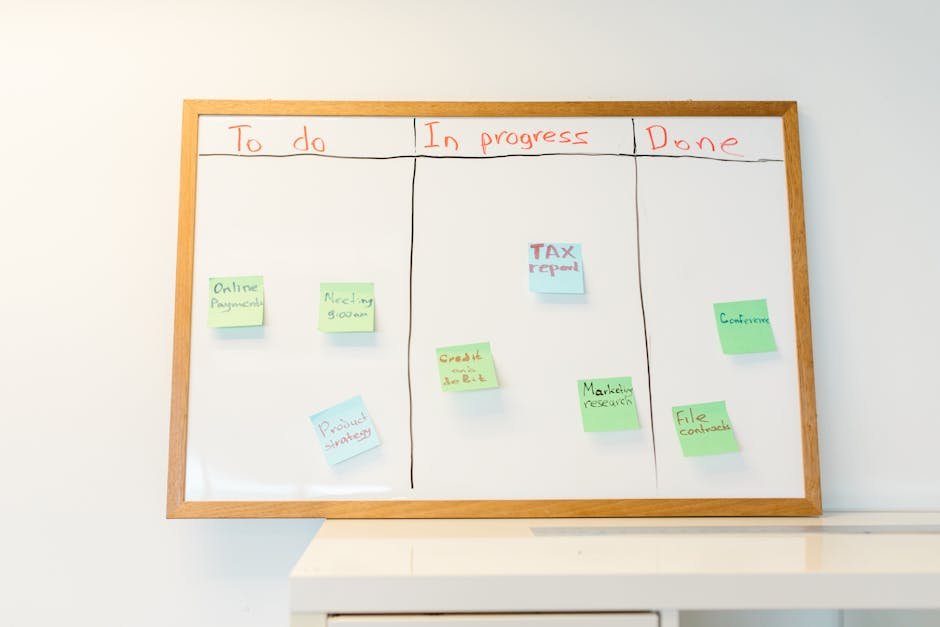Optimizing Kanban Workflow for Maximum Efficiency
In a world where time is money, optimizing workflow processes is crucial for businesses aiming to enhance productivity and reduce waste. The Kanban method, with its roots in manufacturing, has steadily gained popularity as a powerful tool for managing workflow across various industries. This blog post will explore how you can optimize your Kanban workflow for maximum efficiency, ensuring that your team is always working at peak performance.
Understanding the Basics of Kanban
Before diving into optimization techniques, it’s essential to understand the basic principles of Kanban. Kanban, a Japanese term meaning “visual signal,” is a scheduling system initially developed by Toyota to improve efficiency in production processes. The system relies on visual cues to signal the need for action, ensuring a smooth and continuous workflow.
The Core Principles of Kanban
Kanban is built around four core principles:
1. Visualize Work: By representing work visually, teams can easily track progress, identify bottlenecks, and prioritize tasks.
2. Limit Work in Progress (WIP): By capping the number of tasks in progress, teams avoid overloading and maintain focus, leading to higher quality outputs.
3. Manage Flow: Continuous monitoring and management of workflow help to improve efficiency and eliminate bottlenecks.
4. Continuous Improvement: Regularly reviewing and refining processes ensures that the system remains effective and adaptable to change.
Step-by-Step Guide to Optimizing Your Kanban Workflow
Optimizing a Kanban workflow requires a systematic approach. Here, we outline a step-by-step guide to help you achieve maximum efficiency.
Step 1: Evaluate Your Current Workflow
The first step in optimization is to conduct a thorough evaluation of your current workflow. Identify key areas where there are inefficiencies or bottlenecks. Use metrics such as cycle time, lead time, and throughput to gain insights into your process.
According to a survey by the Lean Enterprise Institute, companies that employed Kanban reported a 40% reduction in lead times and a 50% increase in productivity. Conducting a detailed assessment will help you identify similar opportunities for improvement.
Step 2: Visualize Your Workflow
Visualizing your workflow is a fundamental aspect of Kanban. Create a Kanban board that clearly represents the different stages of your process. Use columns to indicate different phases such as “To Do,” “In Progress,” and “Completed.”
Tools like Trello or Jira offer digital Kanban boards that can be customized to suit your specific needs. As per a report by Atlassian, teams using digital Kanban boards experienced a 25% increase in task completion rates.
Step 3: Set Work In Progress (WIP) Limits
Limiting WIP is crucial for maintaining focus and reducing multitasking, which can lead to errors and inefficiencies. Analyze your team’s capacity and set realistic WIP limits for each stage of your workflow.
For instance, if your team struggles to handle more than three tasks simultaneously during the “In Progress” phase, set your WIP limit to three. This practice helps to prevent overloading and ensures a steady flow of work.
Step 4: Manage and Optimize Flow
Regularly monitor the flow of work through your Kanban board. Identify any stages where tasks are frequently stalled and investigate the causes. Are there resource constraints, skill gaps, or process issues hindering progress?
Implement improvements such as redistributing tasks, providing additional training, or upgrading tools and resources to enhance flow. According to a study by McKinsey, optimizing resource allocation can boost productivity by up to 20%.
Step 5: Foster a Culture of Continuous Improvement
Encourage your team to regularly review and reflect on their processes. Conduct retrospectives at the end of each project or sprint to gather feedback and insights. Use this information to make data-driven decisions and implement changes that drive further efficiency.
A survey by Scrum Alliance found that 87% of teams using regular retrospectives reported improved team dynamics and project outcomes.
Real-World Examples of Successful Kanban Optimization
To bring these optimization strategies to life, let’s explore some real-world examples of organizations that have successfully optimized their Kanban workflows.
Example 1: Spotify’s Agile Success
Spotify, a leading music streaming service, adopted the Kanban method to enhance its agile development processes. By visualizing work and setting WIP limits, Spotify was able to reduce lead times and improve collaboration among development teams.
Spotify’s success with Kanban has been attributed to its commitment to continuous improvement and willingness to adapt processes based on team feedback.
Example 2: Zara’s Fast Fashion Efficiency
Zara, a global fashion retailer, utilizes Kanban principles to optimize its supply chain processes. By visualizing inventory levels and setting limits on WIP, Zara can quickly respond to changing fashion trends and consumer demands.
This flexibility has allowed Zara to maintain a competitive edge in the fast-paced fashion industry, with new products reaching stores within weeks rather than months.
Actionable Tips for Optimizing Your Kanban Workflow
Implementing the following actionable tips can further enhance the efficiency of your Kanban workflow:
1. Use Automation Tools: Leverage automation tools to streamline repetitive tasks and reduce manual errors. Tools like Zapier or Automate.io can integrate with your Kanban board to automate workflows and notifications.
2. Enhance Communication: Foster open communication within your team to quickly address issues and share insights. Platforms like Slack or Microsoft Teams can facilitate real-time communication and collaboration.
3. Invest in Training: Provide regular training sessions to ensure your team is well-versed in Kanban principles and best practices. This investment will pay off in the form of improved efficiency and productivity.
4. Regularly Review Metrics: Continuously monitor key performance indicators such as cycle time, lead time, and throughput to assess the effectiveness of your workflow.
Conclusion
Optimizing your Kanban workflow is a strategic process that requires commitment and continuous improvement. By understanding the core principles of Kanban, visualizing your workflow, setting WIP limits, managing flow, and fostering a culture of continuous improvement, you can significantly enhance your team’s efficiency and productivity.
Whether you’re a software development team, a marketing department, or a manufacturing unit, implementing these strategies can lead to measurable improvements in your workflow processes. Embrace the power of Kanban and watch your organization thrive in an increasingly competitive landscape.













